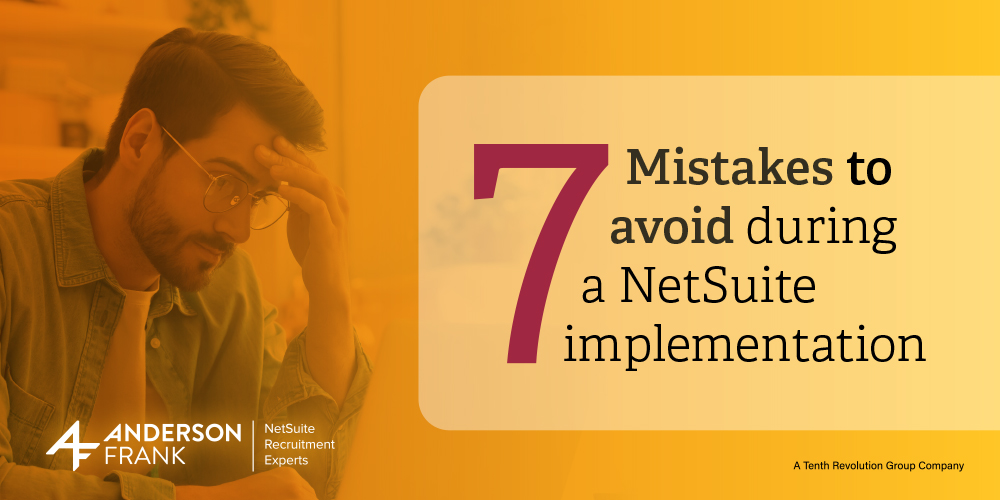7 Mistakes to avoid during a NetSuite implementation
Introducing a new system into a business can prove challenging to any organization, whether it’s changing CRM software or starting a new NetSuite implementation altogether.
Whatever the project is, you will find issues are more likely to occur if you don’t take the time to carefully integrate the project into your business operation.
Any major system transition will affect the day-to-day running of your business, but to prevent a minor hurdle from turning into a serious issue for your company, we suggest understanding what common mistakes are likely to cause delay and learning how to limit the chances of them affecting your project.
40% of businesses experience a delay during their implementation project
NetSuite partners claim the most common factors delaying a company’s NetSuite implementation are often caused by data migration issues, unforeseen customizations, and issues with testing.
Here are seven common mistakes to avoid during a project to guarantee your NetSuite implementation is a big success.
1. Choosing the wrong NetSuite implementation partner
Finding the correct implementation partner for you is a crucial step in the process. This doesn’t just mean finding someone good at their job, but also someone who is trained in implementing software for your specific industry.
You need to find someone that is knowledgeable, reliable, and most importantly, experienced in working with companies like yours. Different partners will have experience in different industries, so finding someone who can tailor your software to your organization’s needs is crucial. NetSuite implementation in a manufacturing and distribution company will be different from a business services organization after all.
Don’t be afraid to ask for references. Speak directly with other companies that have worked with the partner and find out first-hand how their transition went. This will confirm that you have chosen the best partner for your business and better your chances of a smooth implementation.
2. Not migrating data correctly
Migrating data to your new system is a crucial step in the implementation process; without thorough planning and preparation, you can run the risk of your data being corrupted and working incorrectly.
Before implementation, you should consider how you will transfer your data, either manually or via automation. Both have their advantages—doing this manually allows you to cleanse your data, getting rid of any unnecessary data that has built up over the years. Automation, however, makes the process much more efficient and is far less tedious. No matter the approach you take, making sure the data you have transferred is valid is a step that can’t be overlooked, otherwise, you risk the success of your implementation process.
3. Not documenting your current business needs
One of the biggest mistakes companies make when starting a business process migration is not considering what you need from your new system.
In a world turning more tech-heavy every day, it’s understandable that you would want to move straight to the newest system available, however, this doesn’t necessarily mean that this will be best suited to your business. You must consider the needs of your business and find what implementation will be best to help you grow.
Without really examining what you currently do, there’s a chance that you’ll just replicate the systems that your company is currently using, potentially missing out on new interesting process opportunities within NetSuite that will make your business run better. Take the time to understand, and get to know, the platform, and all of its capabilities. It minimizes any further costs later down the line when you find gaps in your system.
NetSuite software can offer your business systems that support not only finance but HR, payroll, CRM, inventory, supply chain, manufacturing, marketing, and e-commerce.
Take time before you start the NetSuite implementation to plan for the future and see what your business will need then. As your company grows, NetSuite will grow with you. You need to make sure your organization has thought about what it has in its business plan for the next five, or even ten, years.
A NetSuite partner can be a great source of help with this. They know what the software system can do and what it offers to an organization. You may not want or need every available feature but be sure you understand what’s possible before you commit to the project.
4. Disregarding the opinions of your employees
When deciding on the outline of the system requirements, ensure that everyone that will use it is invited to discuss what features they use in your current system, and what features would enable them to work more efficiently.
This will not only ensure that you get the best solution for you as a business but shows that you value the experience of your employees by considering their daily tasks. By taking the time to communicate internally, you help to maximize the potential of your new software while also giving your team the tools to excel in their work.
5. Not utilizing the NetSuite sandbox tool
Your employees that will be using NetSuite every day need to have an opportunity to explore and use the system in a safe environment. A NetSuite sandbox offers you that opportunity.
A sandbox is an isolated test account with your real business data included in it. Any changes, mistakes or problems are contained safely away from your live, real-world system. Your users will be able to learn what the new platform can do, as well as how they will use it to complete their daily duties.
Having access to a NetSuite Sandbox is an additional cost on top of your implementation, but taking the time to thoroughly check the functionality of the system far outweighs the potential risks later.
The best people to test this are your employees, as they are the ones that will be using the software on a daily basis. Allowing them to be involved in the NetSuite implementation process not only gives them a better understanding of the system before its installation, but also provides the opportunity to ask any questions and offer valuable input.
This will produce two positive outcomes:
- Your users will be familiar with the system when it goes live, cutting down the resistance to change that can occur with most new system launches.
- They will find hidden flaws and missing actions early in the implementation, saving the business future costs by getting mistakes corrected before launch.
Start saving your company money and time.
Hire a NetSuite professional to help you utilize the NetSuite sandbox feature.
6. Failing to establish a NetSuite implementation team
Implementation of a NetSuite system isn’t a one-time task, it’s something you constantly need to maintain. Your company is going to need at least one person who understands NetSuite and can look after and develop your system in the future. Depending on size, you may need an entire team who are dedicated to implementing and then maintaining your software. At the very least, you’ll need an experienced full-time NetSuite Administrator, or to build a relationship with a contractor who will keep your NetSuite system ticking over perfectly.
In the future, as your company grows, you will want changes made to the system and will need access to a NetSuite Developer to create new or improve current processes. A NetSuite Consultant or Business Analyst is also essential for helping your company plan and use NetSuite to its full potential.
7. Overlooking the importance of training
While obvious, the importance of training is often overlooked in the implementation process – and is also the main reason for failure in many organizations. You need to be willing to allocate your resources to thoroughly training your staff, as without it you cannot expect successful usage in the future.
NetSuite is designed to offer straightforward user interactivity, but everything feels difficult if you have only been shown something for an hour. That’s why finding the right implementation partner is crucial; you need to have someone who not only has the knowledge but the time and communication skills to teach others.
Having your teams actively engage and welcome a new system is unlikely to happen instantly, but good training and support will help the transition happen much more smoothly.
Implementing an enterprise resource planning system is a big step for any organization and shouldn’t be taken lightly. Being careful and making sure you iron out any potential issues early on will go a long way in limiting problems in the long run and ensure your implementation project is a success and you get the most benefit out of the system.
Don’t allow your NetSuite implementation to be delayed
Check out our database of pre-screened, high qualified NetSuite candidates to help with your next implementation.





